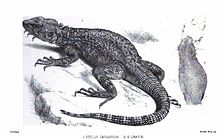Caucasian agama
| Caucasian Agama | |
|---|---|
 | |
| Scientific classification | |
| Domain: | Eukaryota |
| Kingdom: | Animalia |
| Phylum: | Chordata |
| Class: | Reptilia |
| Order: | Squamata |
| Suborder: | Iguania |
| Family: | Agamidae |
| Genus: | Paralaudakia |
| Species: | P. caucasia |
| Binomial name | |
| Paralaudakia caucasia (Eichwald, 1831) | |
| Synonyms | |
| Stellio caucasicus | |
The Caucasian agama (Paralaudakia caucasia) is a species of agamid lizard found in the Caucasus, E/S Georgia, Armenia, Azerbaijan, Turkmenistan, Tajikistan, Dagestan (Russia), E Turkey, Iraq, N Iran, Afghanistan, NW Pakistan, and parts of Kashmir.
Description[edit]
Head much depressed; nostril lateral, below the canthus rostralis, slightly tubular. Upper head-scales smooth; occipital not enlarged; small conical spinose scales on the side of the head near the ear, and on the neck; ear larger than the eye-opening. Throat strongly plicate; no gular pouch. Body much depressed, with a very indistinct lateral fold; nuchal and latero-dorsal scales very small, granular; vertebral region with enlarged flat, feebly keeled, rather irregular scales; flanks with enlarged, strongly keeled or spinose scales; no nuchal denticulation; ventral scales smooth, distinctly smaller than the enlarged dorsals. 150 to 160 scales round the middle of the body. Limbs strong, with compressed digits; the scales on the upper surface of limbs much enlarged, strongly keeled, generally spinose; fourth finger slightly longer than third; fourth toe a little longer than third, fifth extending beyond first. Tail rounded, depressed at the base, covered with rather large spinose scales arranged in rings, two rings forming a distinct segment; the length of the tail doos not equal quite twice the distance from gular fold to vent. Male with a large patch of callose preanal scales and an enormous patch of similar scales on the belly. Olivaceous above, with round yellowish black-edged spots, the black frequently forming a network; vertebral region yellowish, limbs with more or less distinct yellowish cross bars; lower surface yellowish in the female, blackish in the breeding male.[2]
From snout to vent 5 inches.
Notes[edit]
- ^ Aghasyan, A.; Tuniyev, B.; Cogalniceanu, D.; Wilkinson, J.; Ananjeva, N.B.; Orlov, N.L.; Shestapol, A.; Sattorov, T.; Papenfuss, T. (2017). "Paralaudakia caucasia". IUCN Red List of Threatened Species. 2017: e.T164611A1061421. doi:10.2305/IUCN.UK.2017-2.RLTS.T164611A1061421.en. Retrieved 19 November 2021.
- ^ Boulenger, G. A. 1890. Fauna of British India. Reptilia and Batrachia.
References[edit]
- Ananjeva, N. B. and Orlova, V. F. 1979 Distribution and geographic variability of Agama caucasia (Eichwald, 1831) (in Russian). Proceedings of the Zoological Institute of the Academy of Sciences, U.S.S.R. 89, 4-17
- Ananjeva, N.B.; Atajev, J. 1984 Stellio caucasica triannulatus - A new Subspecies of the caucasian Agama from South- Western Turkmenia Trudy Zool. Inst. Akad. Nauk Sssr 124: 4-11
- Ananjeva, N.B. & Tuniev 1994 Some aspects of historical biogeography of Asian rock agamids Russ. J. Herpetol. 1 (1): 43
- Ananjeva, N. & Orlov, N. 2005 Lizards of North Eurasia. Reptilia (GB) (38): 54-63
- Eichwald, E. 1831 Zoologia specialis, quam expositis animalibus tum vivis, tum fossilibus potissimuni rossiae in universum, et poloniae in specie, in usum lectionum publicarum in Universitate Caesarea Vilnensi. Zawadski, Vilnae.
External links[edit]
- Paralaudakia caucasia at the Reptarium.cz Reptile Database
- https://web.archive.org/web/20070110031253/http://itgmv1.fzk.de/www/itg/uetz/herp/photos/Laudakia_caucasia.jpg
- Laudakia caucasia at The Checklist of Armenia's Amphibians and Reptiles at Tadevosyan's Herpetological Resources. Accessed 30 March 2007.


 French
French Deutsch
Deutsch